MARIANI’S
Virtual Gourmet
February
10, 2019
NEWSLETTER
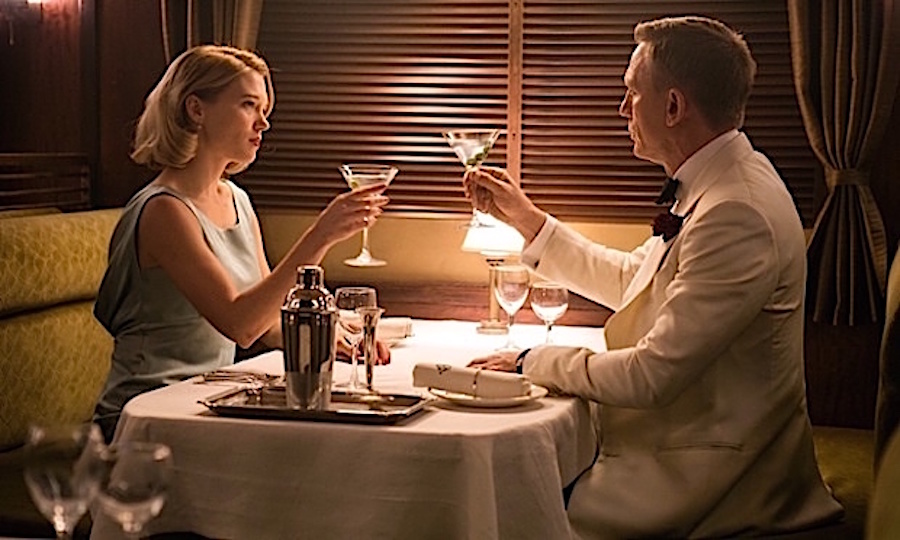
Léa Seydoux and Daniel Craig in "Spectre" (2015)
HAPPY ST. VALENTINE'S DAY
❖❖❖
IN THIS ISSUE
SARATOGA SPRINGS, NY
By John Mariani
NEW YORK CORNER
ZENGO
By John Mariani
NOTES FROM THE WINE CELLAR
MARCO FELLUGA WINES
By John Mariani
❖❖❖
SARATOGA SPRINGS, NY
THE JEWEL OF THE HUDSON VALLEY
By John Mariani
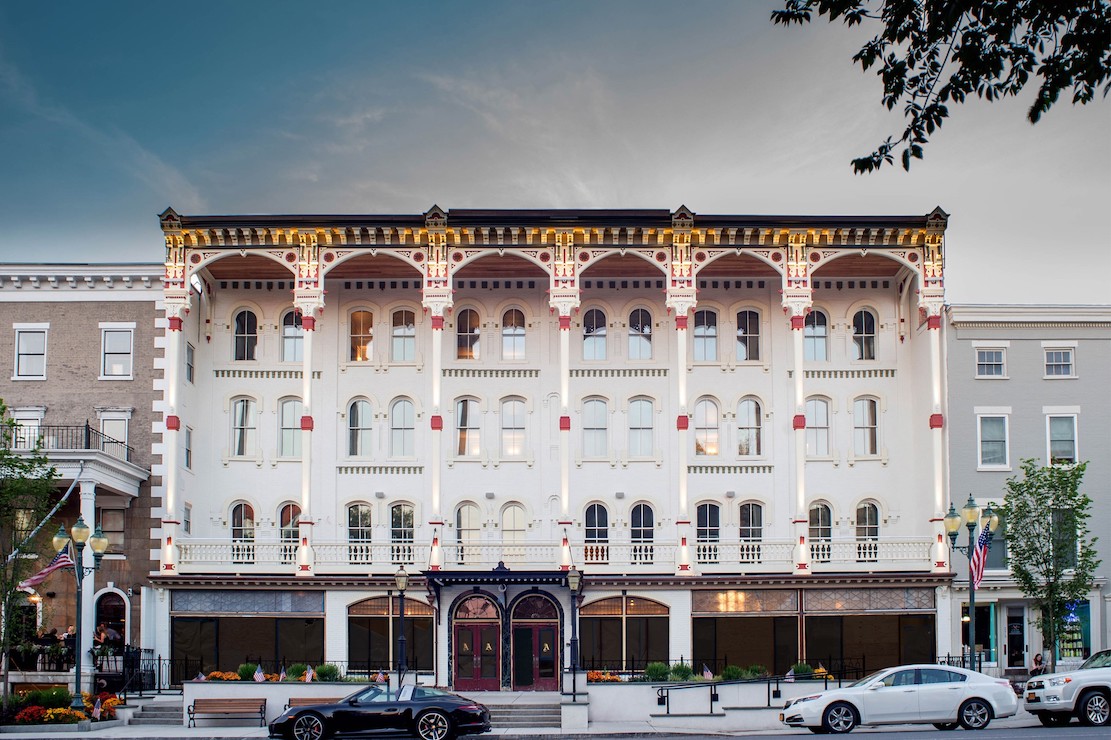
Adelphi Hotel
As someone who once lived in Yonkers, along the Hudson River, which Henry James called “the great romantic stream,” I have never forgotten the peacefulness that a long view of it instilled upon my senses as it flowed silently down to the sea.
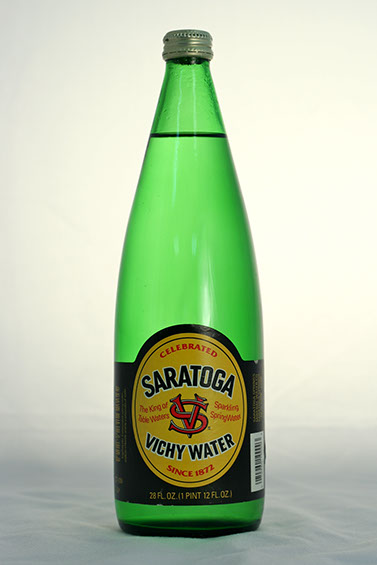 In southern New York the
Hudson is broad and
majestic, growing to its widest point thirty miles
upstream in Haverstock
before narrowing farther north.
The scenery throughout the Hudson Valley is
extraordinary in that so
much of it still looks primeval, from the
Palisades to Albany. Metro-North
Railroad’s Hudson line allows a consistent view of
the river, but the New York
Thruway runs largely west through the Adirondacks,
up to Saratoga Springs. It
is a town enriched by a history of wealth, health,
gambling and racing, and
now, thanks to the renovation of its principal
historic building, The Adelphi
Hotel, Saratoga Springs has never looked more
charming.
In southern New York the
Hudson is broad and
majestic, growing to its widest point thirty miles
upstream in Haverstock
before narrowing farther north.
The scenery throughout the Hudson Valley is
extraordinary in that so
much of it still looks primeval, from the
Palisades to Albany. Metro-North
Railroad’s Hudson line allows a consistent view of
the river, but the New York
Thruway runs largely west through the Adirondacks,
up to Saratoga Springs. It
is a town enriched by a history of wealth, health,
gambling and racing, and
now, thanks to the renovation of its principal
historic building, The Adelphi
Hotel, Saratoga Springs has never looked more
charming.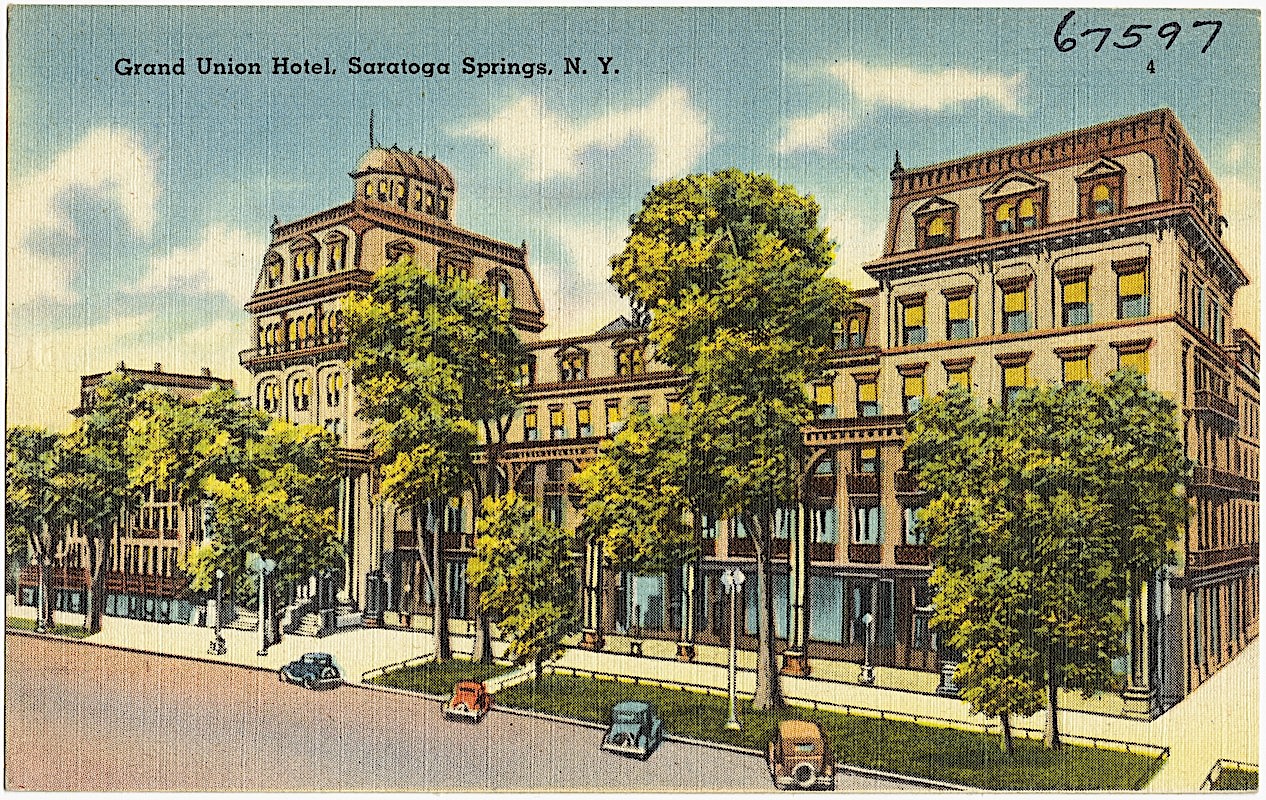
Before there was a town there were mineral springs, unseen by any white man until 1771, when a British general attributed the cure of his leg wound to the miraculous waters of High Rock Spring. After the American Revolution the area became a healthy refuge for luminaries that ranged from George Washington to Alexander Hamilton, and the first hotel opened in 1802. The shipment of Saratoga’s restorative waters to New York City as of the 1830s made the town’s name famous, and, when swift steamboats began plying the Hudson, a gambling casino drew a new crowd to the town and the racetrack made its fortunes well into the 20th century.
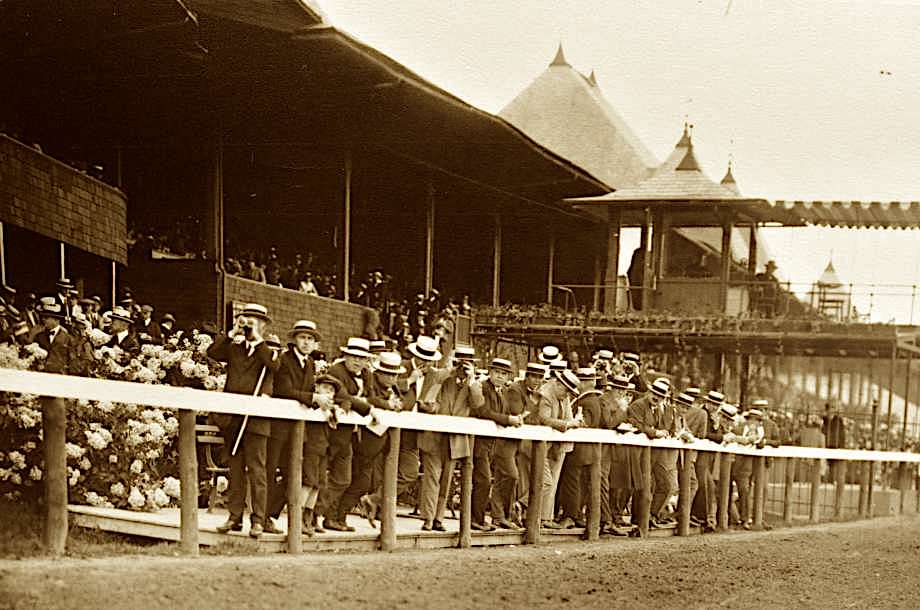 In
the 19th century there were three great
hotels in Saratoga Springs: the Grand Union, with
824 rooms; the United States,
stretching a quarter-mile along Broadway; and The
Adelphi, filigreed in
Victorian gingerbread. Today, only the last
survives, bought several years ago
in a seriously dilapidated condition for a mere
$4.5 million, then gutted and
restored over five years at a cost of $40 million. Today, its façade’s
colonnade is one of the town’s most
identifiable reference points.
In
the 19th century there were three great
hotels in Saratoga Springs: the Grand Union, with
824 rooms; the United States,
stretching a quarter-mile along Broadway; and The
Adelphi, filigreed in
Victorian gingerbread. Today, only the last
survives, bought several years ago
in a seriously dilapidated condition for a mere
$4.5 million, then gutted and
restored over five years at a cost of $40 million. Today, its façade’s
colonnade is one of the town’s most
identifiable reference points.
The result of the restoration is a carefully
maintained balance of the old and the new, with
hardwood and antiques used
throughout, marble tables, 19th century
photographs and a well-appointed
library with tufted leather and velvet chairs, all
putting you in mind of a
place where tycoons like Diamond Jim Brady used to
get away from the bustle of
New York.
But all the rooms, while evoking the ambiance of the hotel’s early incarnation, are completely modern, with complimentary refreshments and Nespresso machine, WiFi, and bathrooms as large as any at a California spa, with double-topped sink, separate tub and shower, an electronic bidet and toilet, heated floors and excellent lighting. There is also complimentary car service within a five-mile radius.
The downstairs bar is named after a bare-knuckles fighter and congressman named John Morrissey, who was also one of the developers of the town’s first casino. Next door to the hotel is a steakhouse called Salt & Char, but the main dining room, within the hotel, is the Blue Hen, set under a spectacular skylight like a gazebo of white wood and glass.
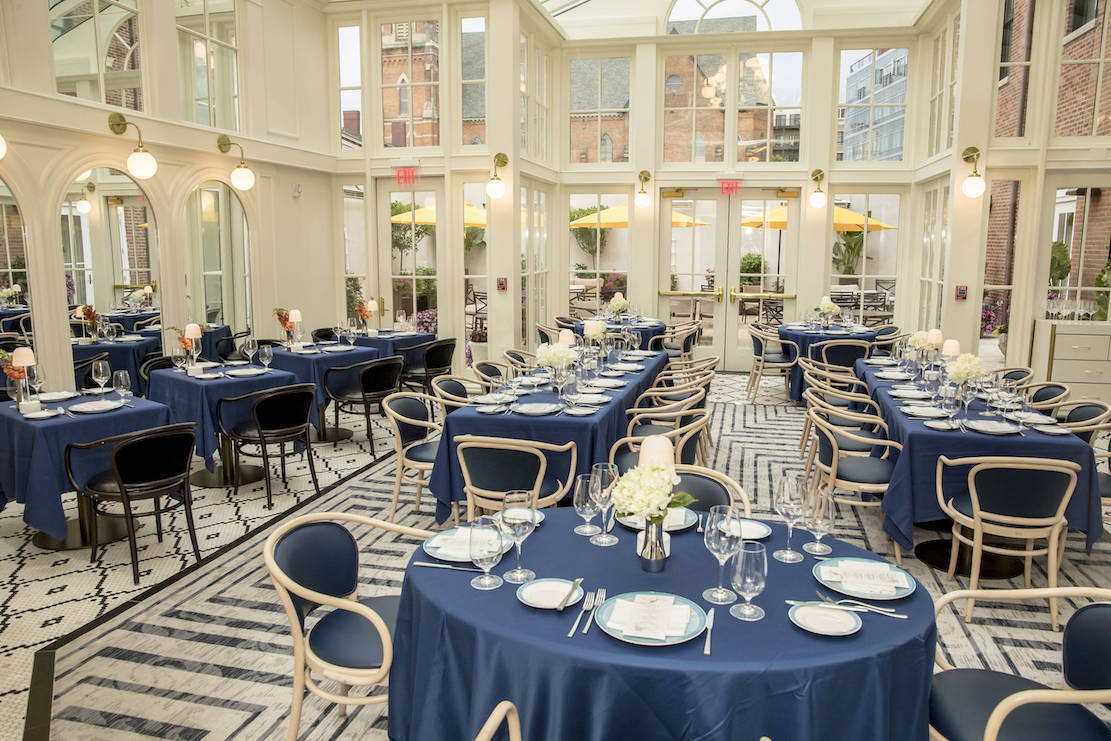 Chef
Chris Bonnivier, who’s worked on the menus
with Chef David Burke, sources provender as much
as possible from the Hudson
Valley and New York State, which translates into
colorfully presented dishes
like crispy glazed pork belly with smoked bleu
cheese, blood orange, parsnips
and pickled chilies ($15); a wintry kabochka
squash bisque with cranberry
gelée, sage and roasted pumpkin seeds ($12);
classically executed lamb
crêpinette (below)
with cabbage puree, spiced carrots, curried
eggplant mostarda
and butter-poached turnip
($44); veal tenderloin with cornmeal puree,
sunchokes and caramelized parsnips
($42); roasted Brussels sprouts ($8); and a lavish
and lovely Paris “tea pot de
crème” with almond, chocolate and hibiscus
meringue crisps ($12).
Chef
Chris Bonnivier, who’s worked on the menus
with Chef David Burke, sources provender as much
as possible from the Hudson
Valley and New York State, which translates into
colorfully presented dishes
like crispy glazed pork belly with smoked bleu
cheese, blood orange, parsnips
and pickled chilies ($15); a wintry kabochka
squash bisque with cranberry
gelée, sage and roasted pumpkin seeds ($12);
classically executed lamb
crêpinette (below)
with cabbage puree, spiced carrots, curried
eggplant mostarda
and butter-poached turnip
($44); veal tenderloin with cornmeal puree,
sunchokes and caramelized parsnips
($42); roasted Brussels sprouts ($8); and a lavish
and lovely Paris “tea pot de
crème” with almond, chocolate and hibiscus
meringue crisps ($12). 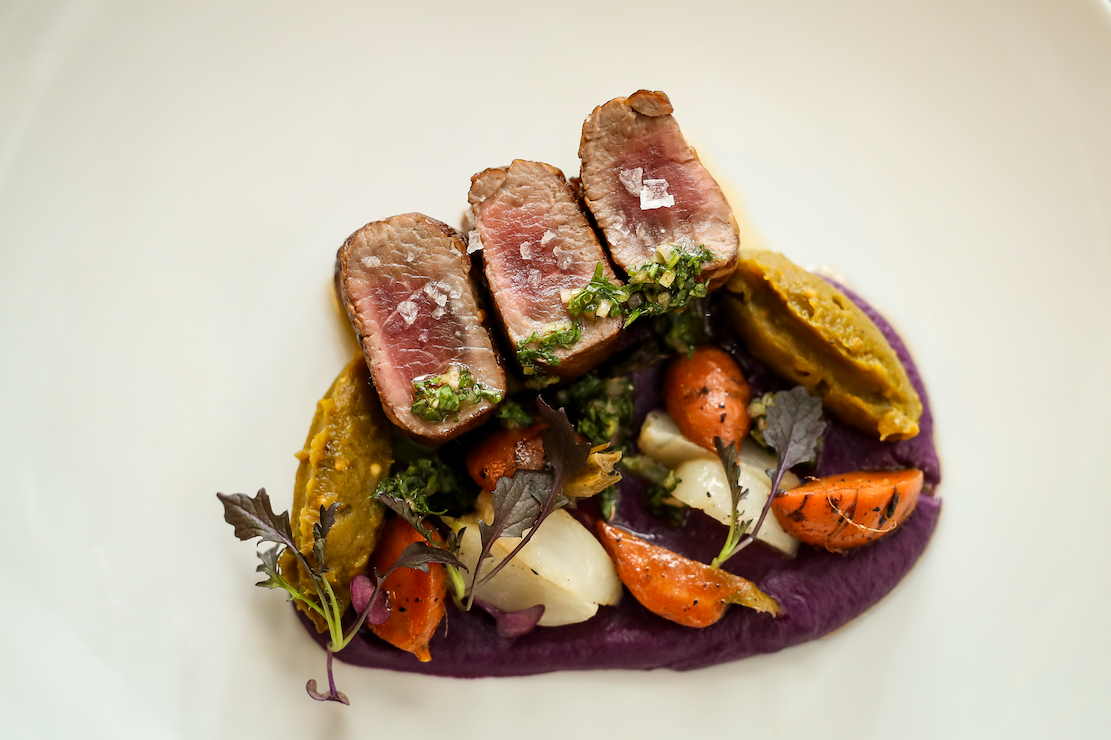
This is a kind of finely crafted cuisine you won’t find anywhere else in Saratoga Springs, whose Broadway is lined with bistros, pizzerias, a deli, bakeries, cafés, sandwich shops, crêperies and ice cream shops.
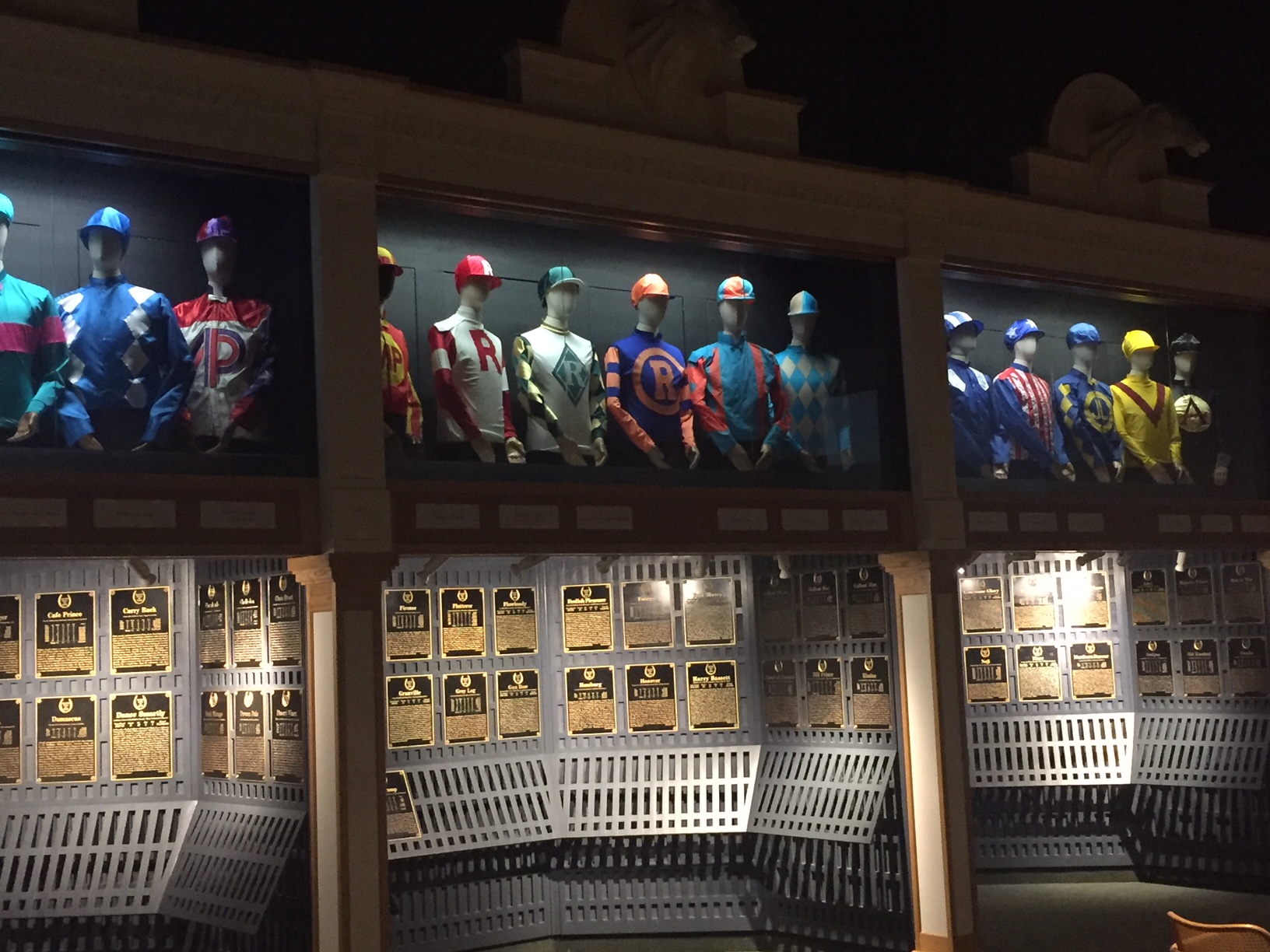 My last visit was this
winter, so not all of
the area’s attractions were open (there’s skiing
an hour away), but the
National Museum
of Racing and Hall of Fame (left) on
Union Avenue is a stunning
presentation of the history of equestrianism in
America, with whole rooms full
of jockey silks, cases of ornate silver trophies,
a reproduced starting gate
and superb archival footage and photos throughout.
My last visit was this
winter, so not all of
the area’s attractions were open (there’s skiing
an hour away), but the
National Museum
of Racing and Hall of Fame (left) on
Union Avenue is a stunning
presentation of the history of equestrianism in
America, with whole rooms full
of jockey silks, cases of ornate silver trophies,
a reproduced starting gate
and superb archival footage and photos throughout.
There is also the Saratoga Automobile Museum;
the National Museum of Dance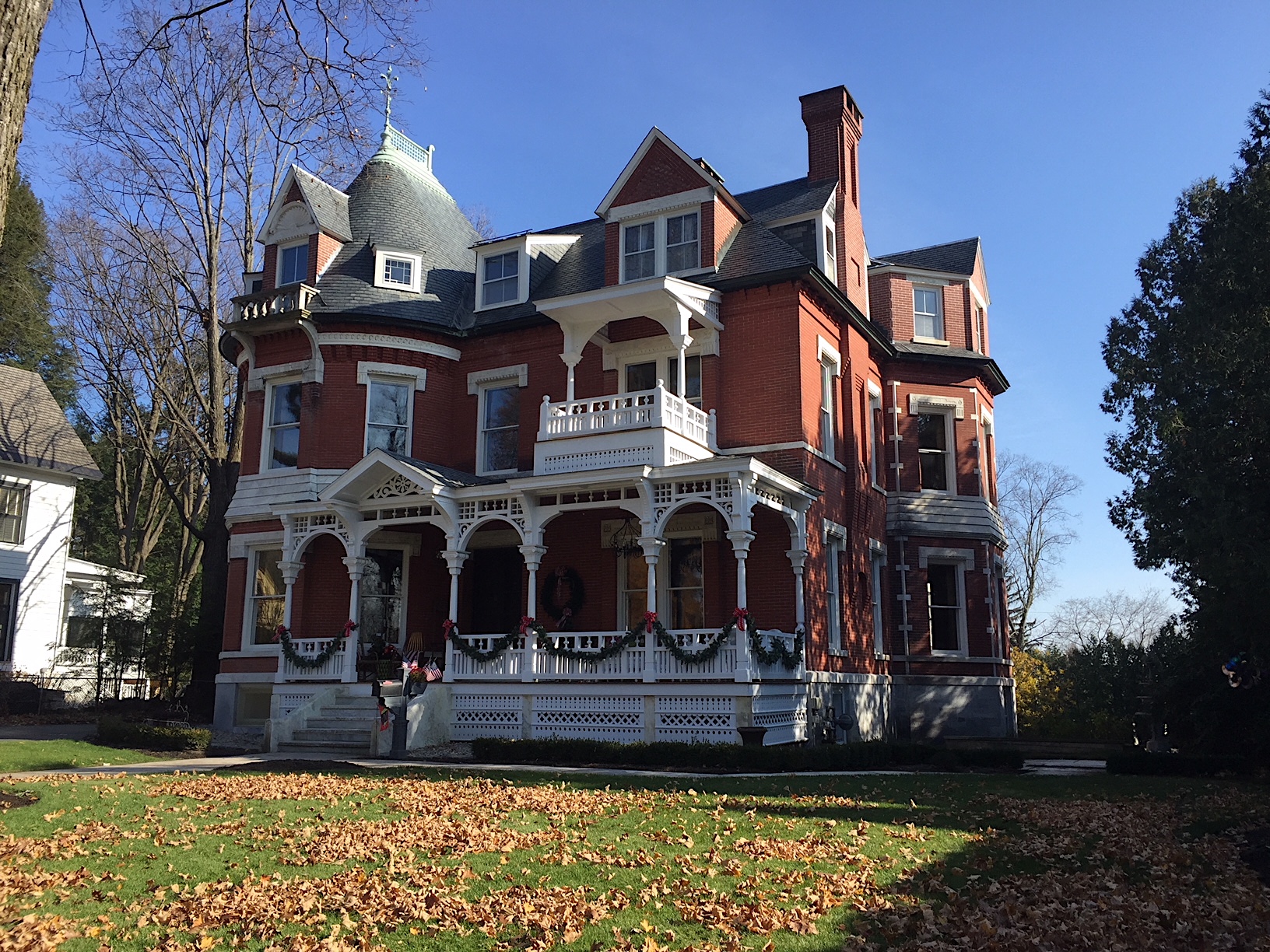 and Hall of Fame; and, in nearby Glenn
Falls, the
Hyde Collection,
Art Museum and Historic House with works
by Rembrandt,
Picasso, Eakins and Homer. Nearby Smith College
may be of interest to some, but
its lay-out and architecture are curiously drab.
and Hall of Fame; and, in nearby Glenn
Falls, the
Hyde Collection,
Art Museum and Historic House with works
by Rembrandt,
Picasso, Eakins and Homer. Nearby Smith College
may be of interest to some, but
its lay-out and architecture are curiously drab.
A great deal of the pleasure of Saratoga Springs, on or off season, is simply to stroll up Broadway, lined with a mile or so of some of America’s most beautiful 19th century asymmetrical mansions, all in excellent shape, brightly colored, some turreted, others with widow’s walks, shingled or brick-wrapped, with bay windows of stained glass and with Gothic Revival, Queen Anne and Italianate decorative elements, not unlike a Hollywood street set for “Meet Me in St. Louis,” only very truly real.
❖❖❖
By John Mariani
ZENGO
622 Third Avenue (at 40th Street)
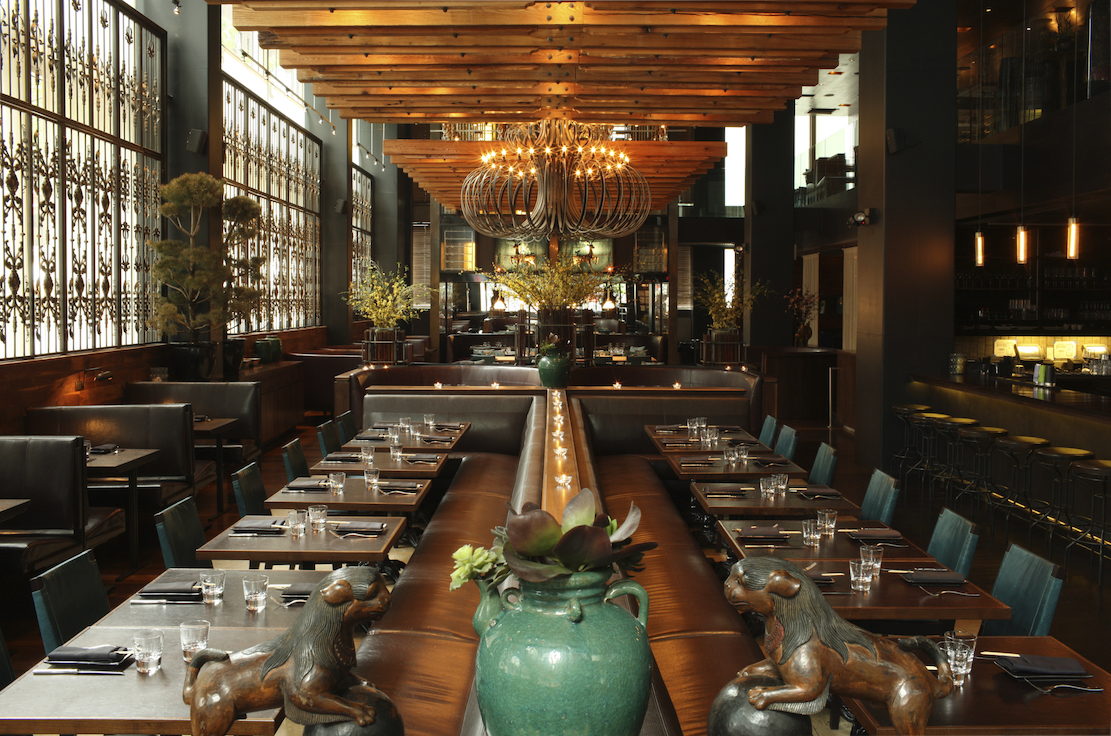
Zengo occupies a vast three-level space once thought doomed as a restaurant location in New York, but nine years from opening it is still thriving in Midtown, just a couple of blocks from Grand Central Terminal. Downstairs there’s a bar called La Biblioteca de Tequila with 400 agave-based spirits (below); on ground level is a huge dining room with high ceilings, masses of dark wood, rafters and wrought-iron screens; on the mezzanine is another, smaller venue. Even on a brutally cold January night midweek, when I visited, Zengo was doing banner business.
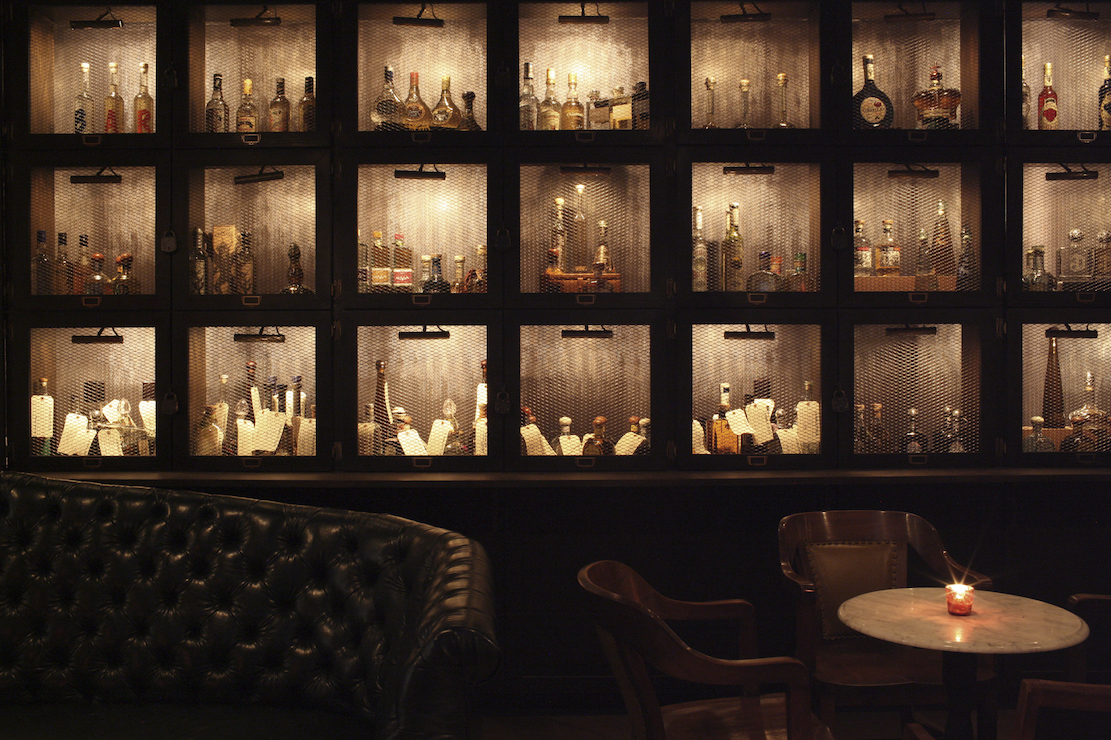 “Zengo”
means "give and take" in
Japanese, something empire-building
chef-owner Richard Sandoval, who grew up in
Mexico City, has been toying with
for years. He began in New York with
restaurants Maya and Pampano, and
over 18 years has gone global, with 45
“concepts” in nine states, Mexico,
Dubai, Qatar and even Serbia.
“Zengo”
means "give and take" in
Japanese, something empire-building
chef-owner Richard Sandoval, who grew up in
Mexico City, has been toying with
for years. He began in New York with
restaurants Maya and Pampano, and
over 18 years has gone global, with 45
“concepts” in nine states, Mexico,
Dubai, Qatar and even Serbia.
There are in fact three Zengos, and there’s no question the New York operation is a “concept” designed to wow a Millennial crowd that comes as much for the scene as the food and drink. It may have taken its cue from Jean-Georges Vongerichten’s Asian restaurants Vong and Spice Market (both long gone), but, fortunately, the food is not formulaic and adds Mexican and Peruvian elements to the menu.
That
menu is way too large to hit on every
note, but it’s hard to resist ordering from so
many categories, making it wise
to go with a group of four or more, as did I.
You can store your own tequila
bottle in a locker downstairs, where the Happy
Hour is held. There are ten
specialty cocktails offered, running $13
to $15.
My friends and I ate from pretty much every category and made but a dent in the menu, which begins with sushi and sashimi. The “Angry Zengo Roll” ($14) was delicious, bulked up with spicy tuna, avocado, chipotle aïoli and cucumber. There’s an omekase chef’s selection of sushi rolls and ceviche ($65), but I found the sashimi platter ($22) was below par in flavor and in cut from what you’ll find at most Japanese sushi bars around town.
With your
drinks it’s pleasant to nibble on salted edamame
peas ($7) or
blistered
shishito peppers with bonito flakes
($10), and you don’t want to miss
a fine fusion dish like spicy lump crab
guacamole with ginger, yuzu, cilantro
and Thai basil with tortilla chips ($19).
There’s a mixed grilled satay of skirt
steak, chicken thigh, pork and
sesame teriyaki ($16).
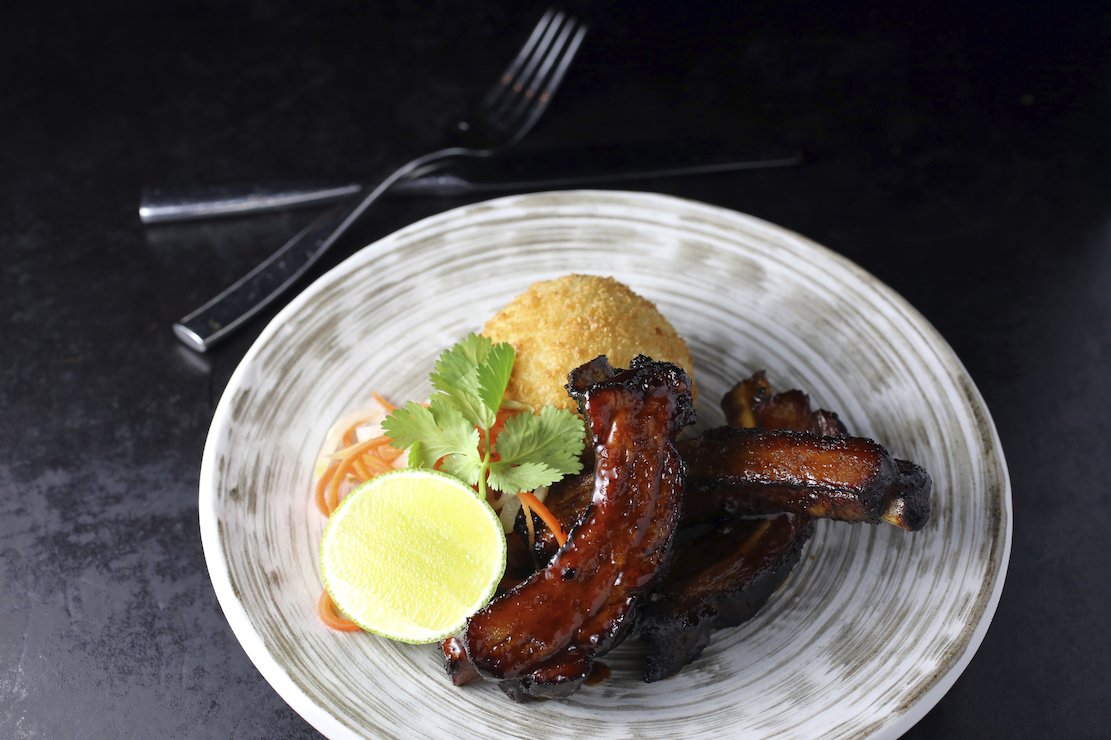 More
out of the ordinary are the highly recommended
Japanese chicken meatballs with
a
sesame and teriyaki glaze ($10). Thai shrimp
lettuce wraps ($15) take on added
interest from chorizo, peanut, cilantro and
tamarind chutney. Also unusual, and
very good, are the foie gras-plantain mofongo shumai
dumplings with black
vinegar sauce, x.o sauce and cilantro
($15).
More
out of the ordinary are the highly recommended
Japanese chicken meatballs with
a
sesame and teriyaki glaze ($10). Thai shrimp
lettuce wraps ($15) take on added
interest from chorizo, peanut, cilantro and
tamarind chutney. Also unusual, and
very good, are the foie gras-plantain mofongo shumai
dumplings with black
vinegar sauce, x.o sauce and cilantro
($15).
Toeing a stricter Mexican line is achiote hoisin pork arepas stuffed with masa and avocado with a rich crema fresca ($14), as are the adobo sweet and sour BBQ pork ribs (left) with papa rellena, bacon, Monterey jack cheese and chayote slaw ($16). This, and a few others, can be sticky sweet, which isn’t what I expected from pork carnitas noodles ($16) with too much hoisin sauce, along with carrots, bean sprouts, a poached egg, cashews and hot & sour sauce to boot.
There are even flatbreads on the menu,
including one with wild mushrooms, black garlic
and goat’s cheese ($13) and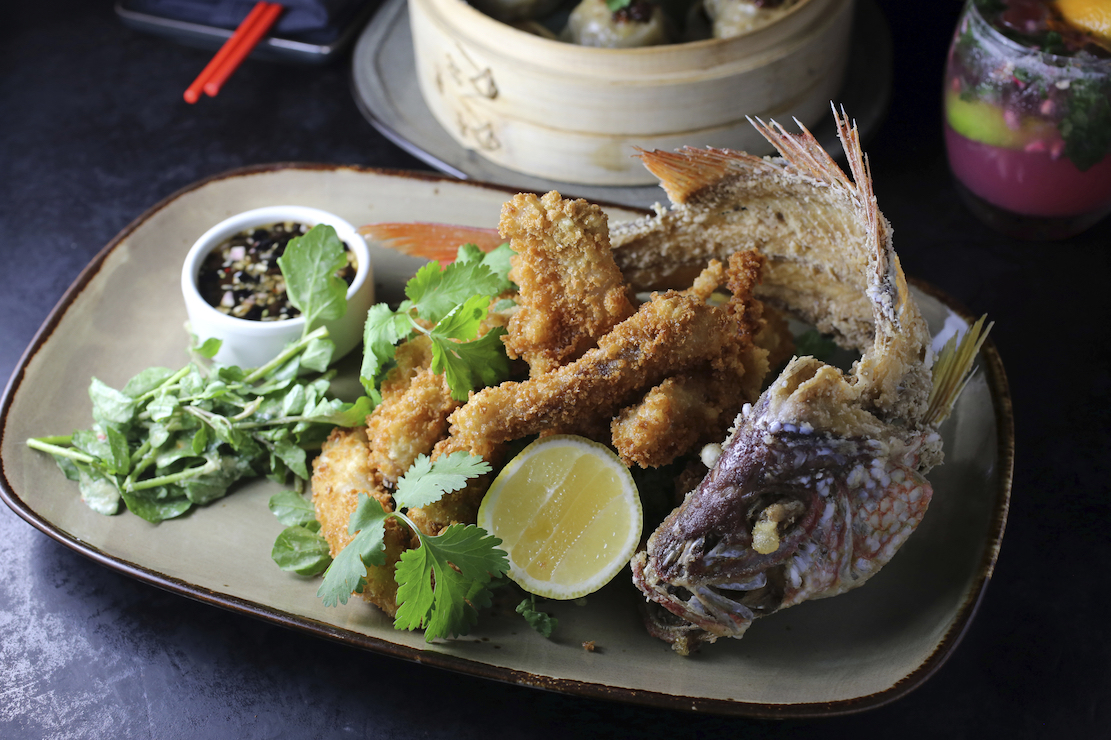 another with Chinese braised short rib with
manchego cheese, arugula and crema
fresca ($15).
another with Chinese braised short rib with
manchego cheese, arugula and crema
fresca ($15).
That takes care of the appetizers. Big main courses follow and can be shared. The best I tried was a whole crispy fried fish (right) with a delightful malanga purée, watercress salad and black bean vinaigrette ($32).
There are just five desserts—quite enough—and you should consider a $25 platter of three or all five for $40. They’re not terrific: the chocolate tres leches cake is spongy; the coconut tapioca pudding lacked flavor, despite the lemon sorbet and guava espuma; and the churros with a bittersweet chocolate sauce hadn’t the right crunch-to-chewy texture.
So Zengo moves on, nearly a decade in this space, and it tries hard to distance itself from those tired, extravagant drinking halls like Tao, where food is negligible and outrageous set-ups are encouraged. Zengo is clearly about the food and drink, and concept or not, it works well.
❖❖❖
By John Mariani
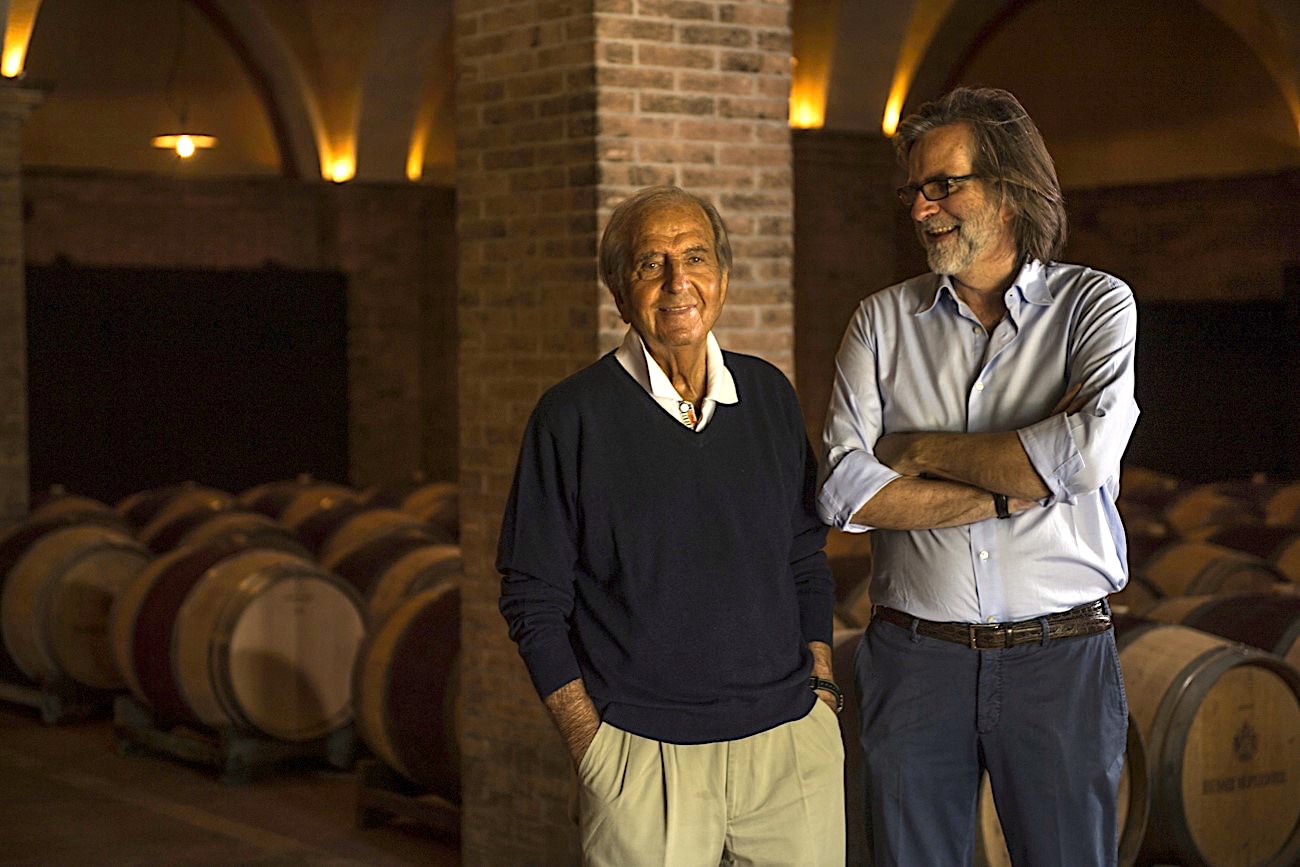
You may be forgiven if you confuse the vintners Marco Felluga and Livio Felluga, both of whose families came originally from Istria, made wine since the 1850s and re-settled in the northern Italian region of Friuli after World War I.
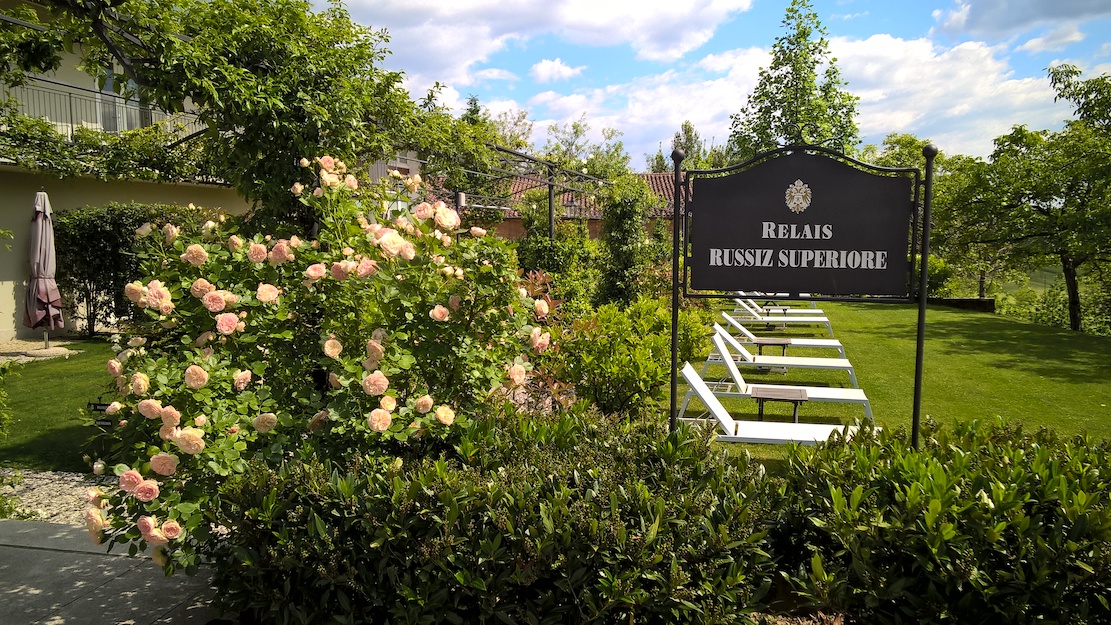 Not until
1956 did the two families split,
quite amiably, and in the mid-1970s began
exporting first-rate Pinot Grigio to
the U.S. at a time when the only Italian white
wines Americans knew were
Frascati, Verdicchio and Soave.
Not until
1956 did the two families split,
quite amiably, and in the mid-1970s began
exporting first-rate Pinot Grigio to
the U.S. at a time when the only Italian white
wines Americans knew were
Frascati, Verdicchio and Soave.
I recall vividly being amazed by the richness, complexity, and aromatics of those Felluga Pinot Grigios (pinot gris in France), but their success resulted in U.S. importers bringing in oceans of mediocre Pinot Grigios, like the way-over-priced Santa Margherita. Today there are more than 600 producers of the varietal, but the Felluga wines outpace them all for quality.
I had occasion last month to dine in New York
with Roberto Felluga, scion of Marco Felluga,
whose vineyards, located in
Gradisco d'Isonzo, cover 120 hectares/300 acres
(either family owned or
operated) in the Collio region, which has a DOC
appellation. The family also
owns 100 hectares/250 acres of Russiz Superiore in
Capriva dei Friuli that
produces Felluga’s most highly 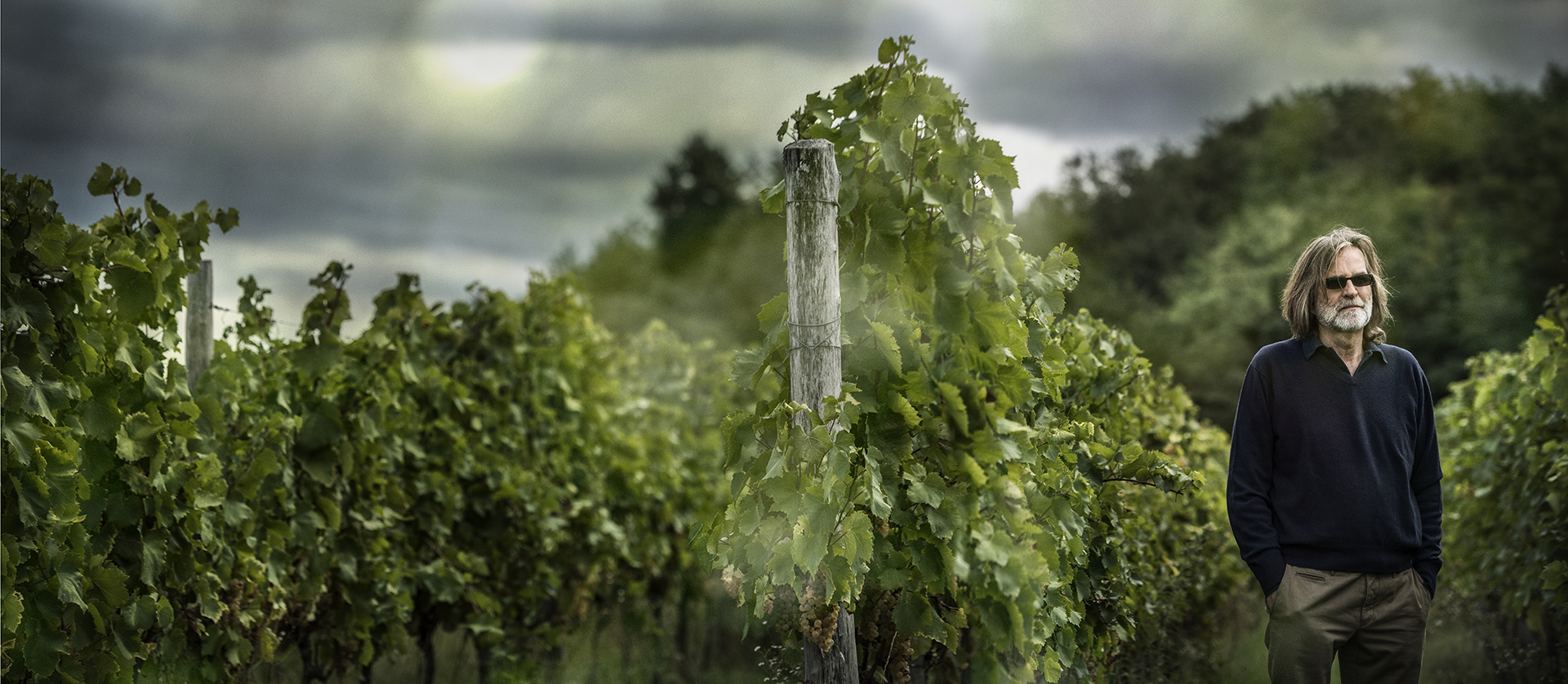 regarded wines. The family’s operations are
only 15 kilometers/9 miles from
Livio Felluga’s.
regarded wines. The family’s operations are
only 15 kilometers/9 miles from
Livio Felluga’s.
Roberto’s father, Marco, has been considered one of the most innovative vintners in Italy, a tradition carried on by Roberto, a tall, slender, bearded fellow who looks quite a bit like The Dude in The Big Lebowski and as much German as he does Italian, given that Friuli is close to the Austrian-German border. (His daughter Ilaria is in training to join the family business.)
“We do have a different, German tradition and approach to wines. We look for freshness and a balance of fruit and acid. Some of our wines are 100% fermented in stainless steel, but others in oak. We also produce a riserva, which is unusual for a white wine.”
We tasted an array of Felluga’s wines, which went with a variety of dishes at Michael’s restaurant that included a bowl of farro and quinoa with pear, cranberries and fromage blanc, mushroom ravioli, grilled Dover sole and delicata squash risotto.
A Collio Pinot Grigio Mongris 2016 Riserva ($36) is 100% Pinot Grigio, with 30% of the must fermented in oak barrels, the remainder in steel, aging for more than two years in bottle, all of which adds to the complexity and richness of this faintly copper-colored wine, so different in refinement from most Pinot Grigio sold in this country.
The Russiz
Superiore Collio Pinot Grigio 2017
($29) is a younger wine, also 100% Pinot Grigio,
from a cool microclimate and
soil rich in clay and limestone. The grapes are
all hand-picked in September,
with 15% fermented in oak, the rest in stainless
steel, then aged on the lees
for eight months and a minimum of one month in
bottle. The wine has an
abundance of aromas, especially pear and apple,
and at 13.5% alcohol a pleasing
heft in the body.
The Russiz Superiore Collio Bianco Col Disore 2013 ($40), with four years of age, is a blend of 40% Pinot Bianco, 35% Tocai Friulano, 15% Sauvignon and 10% Ribolla Gialla. In this case the wine was fermented entirely in oak barrels, aged on the lees for a year and a year in bottle. It’s a white wine that hints at the longevity of German whites, with minerality and vegetable flavors in tandem with the fruit. This was a very good wine to go with the woodsy flavors of the risotto.
Russiz
Superiore Collio Pinot Bianco Riserva
2015 ($36) is made from Pinot Bianco, which often
produces a fairly bland white
wine.
But Felluga picks some of the
grapes in late September and lets the rest
hang until October to become overripe, increasing
the sugar level that turns
into alcohol. It spends three years on the lees
and what emerges is a golden,
faintly sweet wine that is soft on the palate and
rich on the finish, so that
it is a perfect wine for cheeses or shellfish.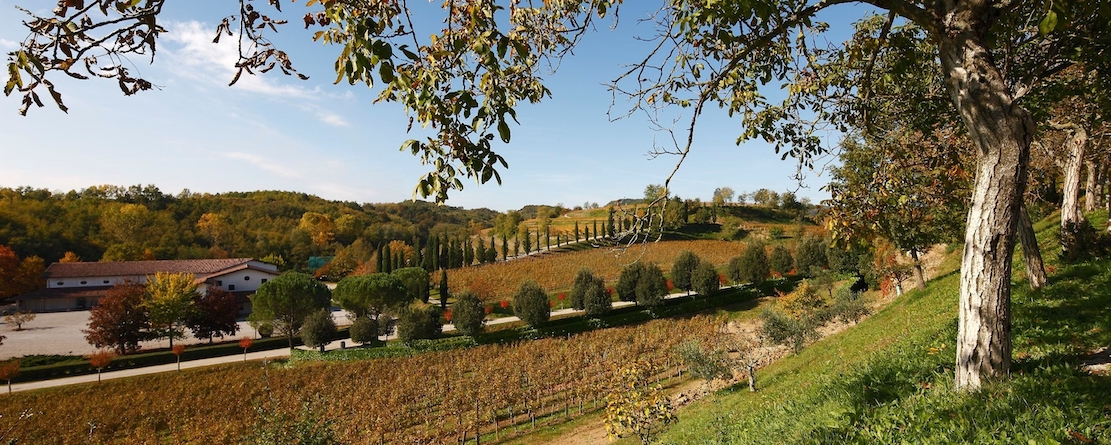
Felluga pointed out that for a long period in
the family history, more red wine was made than
white, and they still make a
considerable amount. That evening
we tasted the Collio Cabernet Franc 2016 ($29),
macerated in stainless steel,
then aged a year in barriques and six months in
bottle. It is richer than many
northern Cabernet Francs, which tend to be rather
light and
one-dimensional.
Today
40% of Felluga’s wines are
exported, and there have even been forays into the
Chinese market. Fortunately,
with limited acreage, quality hangs on attention
to detail, which Felluga has
made a hallmark now for six generations.
❖❖❖
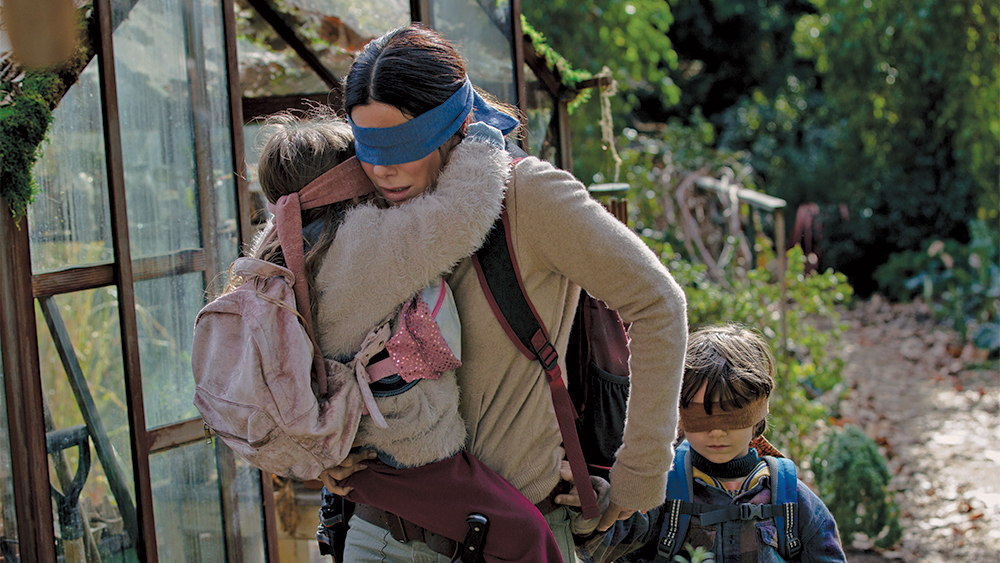
NEXT MONTH'S THEME:
THE HANDMAID'S TALE
The
Milleridge Inn in
Jericho. NY, will “transform into scenes
from the Netflix blockbuster Bird
Box as
hundreds of local residents blindfold themselves
and eat a meal to reenact the iconic scenes of the
movie.” Diners will, as in the movie, not utter a
word throughout the entire dinner, during which
music, bird sounds, and rushing water sounds from
the film will play. Eventually, they’ll be allowed
to enter “the birdhouse,” where they can
take off their blindfolds “without fearing the
monsters.”
FOOD
WRITING 101: TRY HARDER TO SHUT UP
N7, New
Orleans
“When I went to New
Orleans for my 30th (!!) birthday, we went to N7 three
times. I’d never felt so seen by a
restaurant. I could eat there every day for the rest
of my life and die happy (or full of mercury from all
the tinned fish, hard to predict). The wine is divine,
the atmosphere is like a sexy secret garden, the fresh
seafood and fried bar snacks all pull my heartstrings.
Ugh, I want to get on a plane and go back right now.”--Alex Beggs,
"The 22
Restaurants That Turned Us Into Dedicated Regulars in
2018;We can’t shut up about
our new favorite restaurants," Bon Appetit (12/14/19)
Wine
Column Sponsored by Banfi Vintners
SANGIOVESE
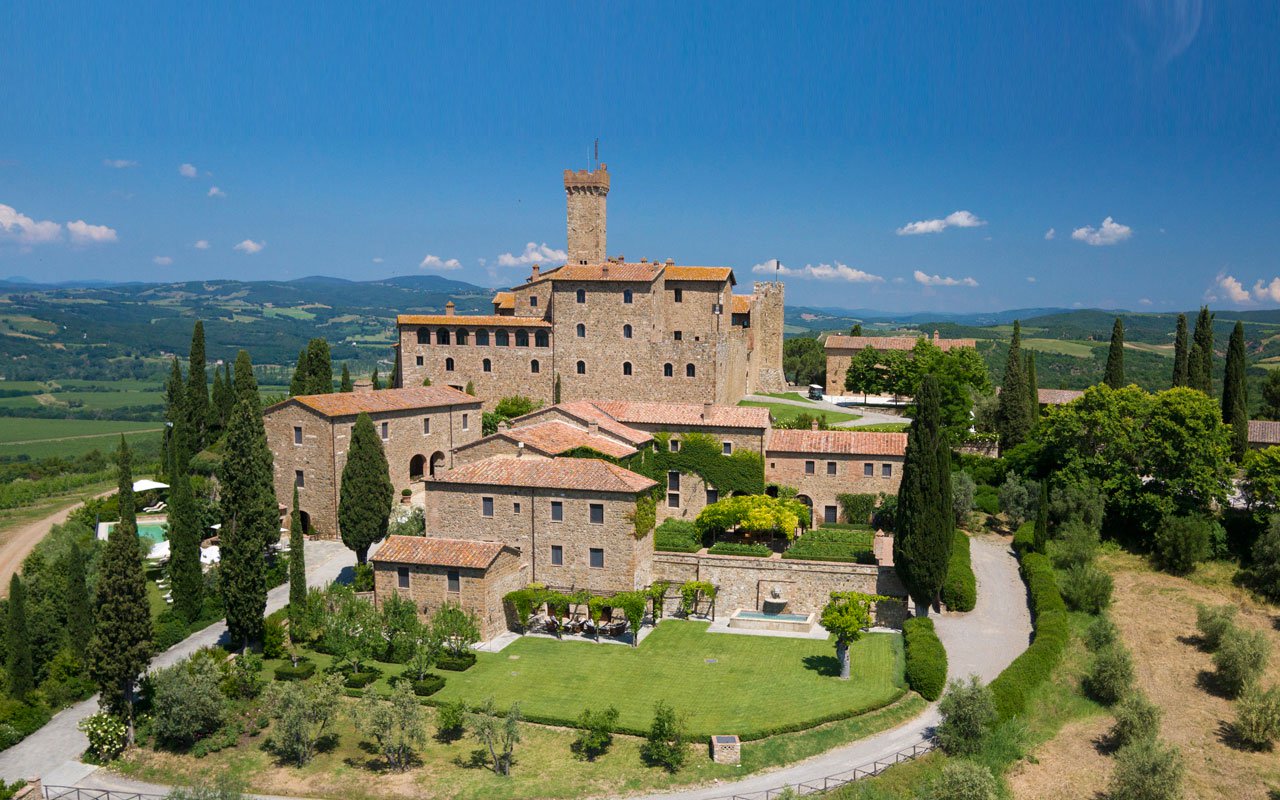 Wine is a joy year-round but
in cooler weather one
grape varietal has really taken center stage in
my daily activities – that most Italian of
grapes, Sangiovese, and its ultimate expression
– Brunello di Montalcino.
Wine is a joy year-round but
in cooler weather one
grape varietal has really taken center stage in
my daily activities – that most Italian of
grapes, Sangiovese, and its ultimate expression
– Brunello di Montalcino.
From mid-September through mid-October,
the Sangiovese grown for our various styles of red
wines are be harvested, culminating with the top
selection for Brunello di Montalcino.
Second, cooler weather here means
it is time to start enjoying more red wines and
especially Sangiovese based wines. That
includes Banfi’s cru of Brunello, Poggio alle Mura,
literally the cream of the crop of our Sangiovese
vineyards. Alongside our Poggio alle Mura Brunello di
Montalcino, this year we introduced two more wines
from the cru Poggio alle Mura – a Rosso di Montalcino
and a Riserva of Brunello. Rosso is sort of like the
younger brother of Brunello, also made from 100%
Sangiovese grapes but usually a selection from younger
vines and the wine is aged only two years compared to
the four required for Brunello. The
Riserva, on the other hand, is an even more selective
harvest of Sangiovese, and ages for an additional year
before release.
What is so special about this cru
Poggio alle Mura?
Well, it is the result our over 30 years of
ongoing research at my family’s vineyard estate,
Castello Banfi.
When we first began planting our vines there in
the late 1970s studies from the University of Bordeaux
indicated which strains of many varietals we should
plant, based on the soil type and microclimate of each
vineyard. But
when it came to the region’s native Sangiovese, there
was only local lore, no scientific research. So we took
it upon ourselves to figure out this vine, and set off
on three decades of incredibly detailed research.
We started
with 600 apparent variations on Sangiovese, because it
is so susceptible to variations in weather and soil,
and narrowed that down to 160 truly genetically
different clones.
We planted a vineyard with two rows of each
type, made wine from each of them, and charted the
differences – remember, you only get one chance a year
to make wine, so this took time.
It took about ten years to get some
concrete results, though we continue to experiment
today and always will – you never stop learning in
science and nature!
Once we determined which were the best,
complementary clones that could be planted together to
make the best Brunello, we chose to plant them in what
we determined to be the optimal vineyard sites. Coincidentally,
the best soils and climate conditions are in the
slopes surrounding the medieval fortress today known
as Castello Banfi, known since Etruscan times as
Poggio alle Mura – the walled hilltop. Hence the
name of our most special “cru” of Brunello,
representing a synthesis between tradition and
innovation.
Though the focus of this study was
our Brunello, all of our Sangiovese-based wines,
including the super Tuscans SummuS, Cum Laude, and
Centine, benefitted from this work. And that’s
the third reason for celebrating Sangiovese this
month, for the range of wonderful reds that usher us
into autumn! One
wine in particular was inspired by our research – the
BelnerO, a Sangiovese dominant blend with what I like
to call a kiss of Cabernet and a whisper of Merlot. We grow the
grapes a little differently for BelnerO than for
Brunello, make the wine with less oak aging and
released it earlier from the winery, providing a
counterpoint to Brunello and a lovely terroir-driven
wine in its own right.
If you
know Italians, you know that by nature we are
multi-faceted, varying in mood, and always passionate. As a
nation, we span from the hot sunny beaches of Sicily
near the African coast to the rugged mountains and
Alpine ski slopes of Trentino-Alto Adige in the north. Sangiovese
is grown in almost all of Italy’s regions and reflects
the unique nature of each; it is most famous
(rightfully so) in Tuscany, yet even there it reflects
the nuances of each hilltop, valley and subzone. It has
something a little different to say in Brunello than
Chianti, Morellino than Vino Nobile di Montepulciano,
Rosso di Montalcino than Super Tuscan blends.
Here is a smattering of
Sangiovese-based wines that you may wish to get to
know better, reflecting a spectrum that appeals to
every occasion, every taste, and every budget. We can
assure you that the conversation will never become
boring. 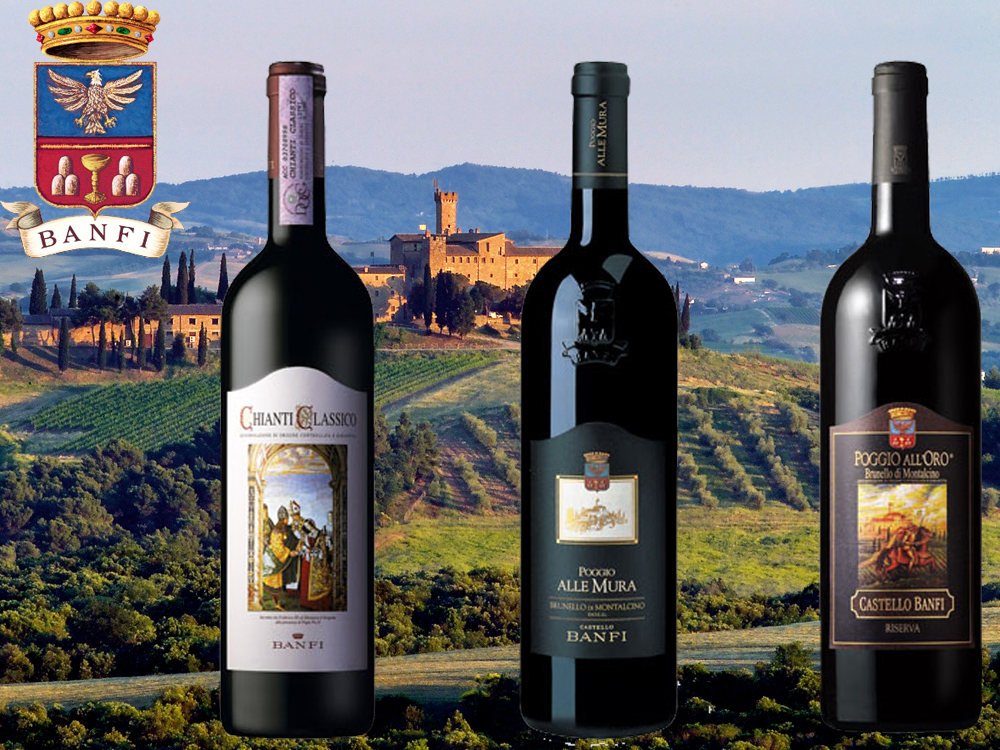
Recommendations for Celebrating
Sangiovese
BelnerO Proprietor’s Reserve Sangiovese
– A refined
cuvée of noble red grapes perfected by our pioneering
clonal research. This dark beauty, BelnerO, is
produced at our innovative winery, chosen 11
consecutive years as Italy’s Premier Vineyard Estate.
Fermented in our patented temperature controlled
French oak and aged approximately 2 additional years.
Unfiltered, and Nitrogen bottled to minimize sulfites.
Castello Banfi Brunello di Montalcino –
Rich, round, velvety and intensely
aromatic, with flavor hints of licorice, cherry, and
spices. Brunello di Montalcino possesses an intense
ruby-red color, and a depth, complexity and opulence
that is softened by an elegant, lingering aftertaste.
Unfiltered after 1998 vintage.
Castello Banfi Rosso di Montalcino – Brunello's "younger brother," produced
from select Sangiovese grapes and aged in barrique for
10 to 12 months. Deep ruby-red, elegant, vibrant,
well-balanced and stylish with a dry velvety
finish.
Poggio all’Oro Brunello di Montalcino
Riserva – A single vineyard selection of our most
historically outstanding Sangiovese, aged five years
before release, the additional year more than that
required of Brunello including 6 months in barrel and
6 months more in bottle to grant its “Riserva”
designation. Incredible
elegance and harmony. Intense with lots of fruit and
subtle wood influence. Round, complete, well balanced
with hints of chocolate and berries. Unfiltered after
1998.
Poggio alle Mura – The first tangible result of years of
intensive clonal research on Montalcino’s native
Sangiovese grape.
Estate bottled from the splendidly sun drenched
vineyards surrounding the medieval Castello from which
it takes its name.
The Brunello
di Montalcino is seductive, silky and smoky. Deep ruby
in color with an expressive bouquet of violets, fruits
and berries as well as cigar box, cedar and exotic
spices. The Rosso
di Montalcino is also intense ruby red. The bouquet
is fresh and fruity with typical varietal notes of
cherry and blackberry, enriched by more complex hints
of licorice, tobacco and hazelnut. It is full
bodied, yet with a soft structure, and a surprisingly
long finish. The Poggio alle Mura Brunello di Montalcino
Riserva is deep ruby red with garnet
reflections and a rich, ample bouquet that hints of
prune jam, coffee, cacao and a light balsamic note. It is full
and powerful, with ripe and gentle tannins that make
it velvety and harmonious; this wine is supported by a
pleasing minerality that to me speaks soundly of that
special hillside in southern Montalcino.
SummuS – A wine of towering elegance, SummuS is an
extraordinary blend of Sangiovese which contributes
body; Cabernet Sauvignon for fruit and structure; and
Syrah for elegance, character and a fruity bouquet. An elegant,
complex and harmonious red wine.
Cum Laude – A complex and elegant red which graduated
“With Honors,” characterized by aromas of juicy
berries and fresh spices.
Centine – A Cuvee that is more than half
Sangiovese, the balanced consisting of equal parts of
Cabernet Sauvignon and Merlot. Vinified in
a firm, round style that easily accompanies a wide
range of dishes, this is a smooth and fragrantly
satisfying wine with international character, and a
perennial favorite at my own dinner table.
Banfi Chianti Superiore – The “Superiore” designation signifies
stricter government regulations regarding production
and aging requirements, as compared to regular
Chianti. An
intense ruby red wine with fruit forward aromas and
floral notes. This
is a round wine with well-balanced acidity and fruit.
Banfi Chianti Classico – An enduring classic: alluring
bouquet of black fruit and violets; rich flavors of
cherry and leather; supple tannins and good acidity
for dining.
Banfi Chianti Classico Riserva – Produced from select grapes grown in the
"Classico" region of Chianti, this dry, fruity and
well-balanced red has a full bouquet reminiscent of
violets.
Fonte alla Selva Chianti Classico – This is our newest entry into the Chianti
arena, coming from a 99 acre estate in Castellina, the
heart of the Chianti Classico region. The wine is
a captivating mauve red that smells of cherry, plum
and blackberry with hints of spice. It is
round, full and balanced with very good
acidity.
Col di Sasso – Sangiovese and Cabernet Sauvignon. Luscious,
complex and soft with persistent notes of fruit and
great Italian style structure.
Any of John Mariani's books below may be ordered from amazon.com.
 The Hound in Heaven
(21st Century Lion Books) is a novella, and
for anyone who loves dogs, Christmas, romance,
inspiration, even the supernatural, I hope you'll find
this to be a treasured favorite. The story
concerns how, after a New England teacher, his wife and
their two daughters adopt a stray puppy found in their
barn in northern Maine, their lives seem full of promise.
But when tragedy strikes, their wonderful dog Lazarus and
the spirit of Christmas are the only things that may bring
his master back from the edge of despair.
The Hound in Heaven
(21st Century Lion Books) is a novella, and
for anyone who loves dogs, Christmas, romance,
inspiration, even the supernatural, I hope you'll find
this to be a treasured favorite. The story
concerns how, after a New England teacher, his wife and
their two daughters adopt a stray puppy found in their
barn in northern Maine, their lives seem full of promise.
But when tragedy strikes, their wonderful dog Lazarus and
the spirit of Christmas are the only things that may bring
his master back from the edge of despair. WATCH THE VIDEO!
“What a huge surprise turn this story took! I was completely stunned! I truly enjoyed this book and its message.” – Actress Ali MacGraw
“He had me at Page One. The amount of heart, human insight, soul searching, and deft literary strength that John Mariani pours into this airtight novella is vertigo-inducing. Perhaps ‘wow’ would be the best comment.” – James Dalessandro, author of Bohemian Heart and 1906.
“John Mariani’s Hound in Heaven starts with a well-painted portrayal of an American family, along with the requisite dog. A surprise event flips the action of the novel and captures us for a voyage leading to a hopeful and heart-warming message. A page turning, one sitting read, it’s the perfect antidote for the winter and promotion of holiday celebration.” – Ann Pearlman, author of The Christmas Cookie Club and A Gift for my Sister.
“John Mariani’s concise, achingly beautiful novella pulls a literary rabbit out of a hat – a mash-up of the cosmic and the intimate, the tragic and the heart-warming – a Christmas tale for all ages, and all faiths. Read it to your children, read it to yourself… but read it. Early and often. Highly recommended.” – Jay Bonansinga, New York Times bestselling author of Pinkerton’s War, The Sinking of The Eastland, and The Walking Dead: The Road To Woodbury.
“Amazing things happen when you open your heart to an animal. The Hound in Heaven delivers a powerful story of healing that is forged in the spiritual relationship between a man and his best friend. The book brings a message of hope that can enrich our images of family, love, and loss.” – Dr. Barbara Royal, author of The Royal Treatment.
 |
The Encyclopedia of American Food and Drink by John F. Mariani (Bloomsbury USA, $35) Modesty forbids me to praise my own new book, but let me proudly say that it is an extensive revision of the 4th edition that appeared more than a decade ago, before locavores, molecular cuisine, modernist cuisine, the Food Network and so much more, now included. Word origins have been completely updated, as have per capita consumption and production stats. Most important, for the first time since publication in the 1980s, the book includes more than 100 biographies of Americans who have changed the way we cook, eat and drink -- from Fannie Farmer and Julia Child to Robert Mondavi and Thomas Keller. "This book is amazing! It has entries for everything from `abalone' to `zwieback,' plus more than 500 recipes for classic American dishes and drinks."--Devra First, The Boston Globe. "Much needed in any kitchen library."--Bon Appetit. |
"Eating Italian will never be the same after reading John Mariani's entertaining and savory gastronomical history of the cuisine of Italy and how it won over appetites worldwide. . . . This book is such a tasteful narrative that it will literally make you hungry for Italian food and arouse your appetite for gastronomical history."--Don Oldenburg, USA Today. "Italian
restaurants--some good, some glitzy--far
outnumber their French rivals. Many of
these establishments are zestfully described
in How Italian Food Conquered the World, an
entertaining and fact-filled chronicle by
food-and-wine correspondent John F.
Mariani."--Aram Bakshian Jr., Wall Street
Journal.
"Equal parts
history, sociology, gastronomy, and just
plain fun, How Italian Food Conquered the
World tells the captivating and delicious
story of the (let's face it) everybody's
favorite cuisine with clarity, verve and
more than one surprise."--Colman Andrews,
editorial director of The Daily
Meal.com. "A fantastic and fascinating
read, covering everything from the influence
of Venice's spice trade to the impact of
Italian immigrants in America and the
evolution of alta cucina. This book will
serve as a terrific resource to anyone
interested in the real story of Italian
food."--Mary Ann Esposito, host of PBS-TV's
Ciao
Italia. "John Mariani has written the
definitive history of how Italians won their
way into our hearts, minds, and
stomachs. It's a story of pleasure over
pomp and taste over technique."--Danny Meyer,
owner of NYC restaurants Union Square
Cafe, The Modern, and Maialino.
|
 |
 |
 |
 |
 |
 |
 |
 |
 Everett Potter's Travel Report:
Everett Potter's Travel Report: 
 Eating Las Vegas
JOHN CURTAS has been covering the Las Vegas
food and restaurant scene since 1995. He is
the co-author of EATING LAS VEGAS – The 50
Essential Restaurants (as well as
the author of the Eating Las Vegas web site: www.eatinglasvegas.
He can also be seen every Friday morning as
the “resident foodie” for Wake Up With the
Wagners on KSNV TV (NBC) Channel 3 in
Las Vegas.
Eating Las Vegas
JOHN CURTAS has been covering the Las Vegas
food and restaurant scene since 1995. He is
the co-author of EATING LAS VEGAS – The 50
Essential Restaurants (as well as
the author of the Eating Las Vegas web site: www.eatinglasvegas.
He can also be seen every Friday morning as
the “resident foodie” for Wake Up With the
Wagners on KSNV TV (NBC) Channel 3 in
Las Vegas.
MARIANI'S VIRTUAL GOURMET
NEWSLETTER is published weekly. Publisher: John Mariani. Editor: Walter Bagley. Contributing Writers: Christopher Mariani,
Robert Mariani, Misha Mariani, John A. Curtas, Gerry Dawes, Geoff Kalish,
and Brian Freedman. Contributing
Photographer: Galina Dargery. Technical
Advisor: Gerry
McLoughlin.
If you wish to subscribe to this
newsletter, please click here: http://www.johnmariani.com/subscribe/index.html
© copyright John Mariani 2019

